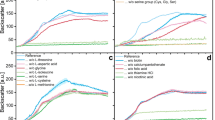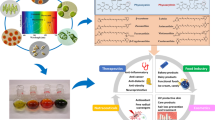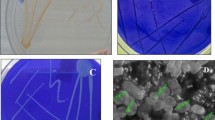Abstract
The aim of this work was to study the pyocyanin pigment from Pseudomonas aeruginosa DN9. The work involves optimization of process parameters for enhanced production of pyocyanin pigment under submerged fermentation condition. During optimization process, maximum pyocyanin production (92.12 µg/ml) was obtained with carbon source mannitole, nitrogen source peptone, inorganic salt NaCl and metal ion FeSO4. Plackett Burman design and Response Surface Methodology (RSM) showed peptone, NaCl and KH2PO4 are significant variable in the production of pyocyanin pigment. The FTIR and GC–MS study was done to evaluate structural properties of pyocyanin pigment. The purified pigment was further analyzed as colouring agent and for inhibitory action against pathogenic microorganisms. Thus, present study showed Pseudomonas aeruginosa DN9 as promising culture for pigment production with potential biotechnological application.



Similar content being viewed by others
References
Hussaini FH, Halbus AF. Rapid decolorization of cobalamin. Int J Photoenergy. 2012;2012:1–9. https://doi.org/10.1155/2012/495435.
Natarajan S, Bajaj HC, Tayade RJ. Recent advances based on the synergetic effect of adsorption for removal of dyes from waste water using photocatalytic process. J Environ Sci (China). 2018;65:201–22. https://doi.org/10.1016/j.jes.2017.03.011.
Gupta VK, Tyagi I, Agarwal S, Sadegh H, Shahryarighoshekandi R, Yari M, Yousefinejat O. Experimental study of surfaces of hydrogel polymers hema, hema-eema-ma, and PVA as adsorbent for removal of azo dyes from liquid phase. J Mol Liq. 2015;206:129–36. https://doi.org/10.1016/j.molliq.2015.02.015.
Ozdemir O, Turan M, TuranAZ FA, Engin AB. Feasibility analysis of color removal from textile dyeing wastewater in a fixed-bed column system by surfactant-modified zeolite (SMZ). J Hazard Mater. 2009;166(2–3):647–54. https://doi.org/10.1016/j.jhazmat.2008.11.123.
Nusrat T, Sharf IS, Geetanjali R, Saif AC, Inamuddin AMA. Nano-engineered adsorbent for the removal of dyes from water: a review. Curr Anal Chem. 2020;16:14–40. https://doi.org/10.2174/1573411015666190117124344.
Hizbullahi MU, Nafu A, Mustapha G, Hauwau MM. Bacterial pigments and its significance. MOJ Bioequiv Availab. 2017;4(3):285–8. https://doi.org/10.15406/mojbb.2017.04.00073.
Dawoud TM, Alharbi NS, Theruvinthalakal AM, Thekkangil A, Kadaikunnan S, Khaled JM, Almanaa TN, Sankar K, Innasimuthu GM, Alanzi KF, Rajaram SK. Characterization and antifungal activity of the yellow pigment produced by a Bacillus sp. DBS4 isolated from the lichen Dirinaria agealita. Saudi J Biol Sci. 2020;27:1403–11. https://doi.org/10.1016/j.sjbs.2019.11.031.
Qayyum S, Basharat S, Mian AH, Qayum S, Ali M, Changsheng P, Shahzad M, Sultan F. Isolation, identifcation and antibacterial study of pigmented bacteria. Appl Nanosci. 2020. https://doi.org/10.1007/s13204-020-01363-5.
Soliev AB, Hosokawa K, Enomoto K. Bioactive pigments from marine bacteria: applications and physiological roles. Evid Based Complement Altern Med. 2011. https://doi.org/10.1155/2011/670349.
Ozdal M. A new strategy for the efficient production of pyocyanin, a versatile pigment, in Pseudomonas aeruginosa OG1 via toluene addition. 3 Biotech. 2019;9:374. https://doi.org/10.1007/s13205-019-1907-1.
Wu CH, Yet-Pole I, Chiu YH, Lin CW. Enhancement of power generation by toluene biodegradation in a microbial fuel cell in the presence of pyocyanin. J Taiwan Inst Chem Engrs. 2014;45:2319–24. https://doi.org/10.1016/j.jtice.2014.05.019.
Saha S, Thavasi R, Jayalakshmi S. Phenazine pigments from Pseudomonas aeruginosa and their application as antibacterial agent and food colourants. Res J Microbiol. 2008;3(3):122–8. https://doi.org/10.3923/jm.2008.122.128.
Essar DW, Eberly LEE, Hadero A, Crawford IP. Identification and characterization of genes for a second anthranilate synthase in Pseudomonas aeruginosa: interchangeability of the two anthranilate synthases and evolutionary implications. J Bacteriol. 1990;172(2):884–900. https://doi.org/10.1128/jb.172.2.884-900.1990.
Poorniammal R, Parthiban M, Gunasekaran S, Murugesan R, Thilagavathi G (2013) Natural dye production from Thermomyces sp fungi for textile application. Indian J Fiber Text 38:272–279. http://hdl.handle.net/123456789/21425
Kavitha K, Mathiyazhagan S, Sendhilvel V, Nakkeeran S, Chandrasekar G, Dilantha Fernando WG. Broad spectrum action of phenazine against active and dormant structures of fungal pathogens and root knot nematode. Arch Phytopathol Plant Protect. 2005;38:69–76. https://doi.org/10.1080/03235400400008408.
Ozcan D, Kahraman H. Pyocyanin production in the presence of calcium ion in Pseudomonas aeruginosa and recombinant bacteria. Turk J Sci Tech. 2015;10(1):13–9.
Agrawal AH, Chauhan PB. Effect of cultivation media components on pyocyanin production and its application in antimicrobial property. Int J Curr Adv Res. 2016;5(4):829–33.
Frank LH, De Moss RD. On the biosynthesis of pyocyanine. J Bacteriol. 1958;77:776–82.
El-Fouly MZ, Sharaf AM, Shahin AAM, Heba A, El-Bialy OAMA. Biosynthesis of pyocyanin pigment by Pseudomonas aeruginosa. J Radiat Res Appl Sci. 2015;8:36–48. https://doi.org/10.1016/j.jrras.2014.10.007.
Das S, Das P. Effects of cultivation media components on biosurfactant and pigment production from Pseudomonas aeruginosa PAO1. Braz J Chem Eng. 2015;32:317–24. https://doi.org/10.1590/0104-6632.20150322s00003262.
Mathew A, Eldo AN, Molly AG. Production optimization, characterization and antimicrobial activity of pyocyanin from Pseudomonas aeruginosa SPC B 65. Biotechnol (Rajkot). 2011;5(5):297–301.
Palumbo A. Role of iron and sulfur in pigment and slime formation by Pseudomonas aeruginosa. J Bacteriol. 1972;2:430–6. https://doi.org/10.1128/jb.111.2.430-436.1972.
Yuan L, Li YQ, Wang Y, Zhang XH, Xu YQ. Optimization of critical medium components using response surface methodology for phenazine-1-carboxylic acid production by Pseudomonas sp M-18Q. J Biosci Bioeng. 2008;105(3):232–7. https://doi.org/10.1263/jbb.105.232.
Patil S, Nikam M, Patil H, Anokhina T, Kochetkov VV, Chaudhari A. Bioactive pigment production by Pseudomonas spp MCC 3145: statistical media optimization, biochemical characterization, fungicidal and DNA intercalation-based cytostatic activity. Process Biochem. 2017;58:298–305. https://doi.org/10.1016/j.procbio.2017.05.003.
Gaber AAZ, Elsayed EW, Saleh MM, Nader AA, Elsayed EH. Optimization of pyocyanin production from Pseudomonas aeruginosa JY21 using statistical experimental designs. Int J Chem Tech Res. 2015;8(9):137–48.
Preetha R, Jayaprakash NS, Philip R, Singh ISB. Optimization of carbon and nitrogen sources and growth factors for the production of an aquaculture probiotic (Pseudomonas MCCB 103) using response surface methodology. J Appl Microbiol. 2007;102:1043–51. https://doi.org/10.1111/j.1365-2672.2006.03149.x.
Devnath P, Uddin K, Ahamed F, Hossain T, Manchur MA. Extraction, purification and characterization of pyocyanin produced by Pseudomonas aeruginosa and evaluation for its antimicrobial activity. Int Res J Biol Sci. 2017;6(5):1–9.
DeBritto S, Gajbar TD, Satapute P, Sundaram L, Lakshmikantha RY, Jogaiah S, Ito SI. isolation and characterization of nutrient dependent pyocyanin from Pseudomonas aeruginosa and its dye and agrochemical properties. Sci Rep. 2020;10:1542. https://doi.org/10.1038/s41598-020-58335-6.
Mullaiselvan I, Kanagara V, Dharmar B, Balaraman M, Meignanalakshmi S. Production, characterization and cytotoxic evaluation of pyocyanin pigment extracted from pseudomonas aeruginosa isolated from industrial soil resources. Int J Curr Microbiol App Sci. 2020;9(3):2117–30. https://doi.org/10.20546/ijcmas.2020.903.242.
Aziz LM, Hamza SJ, Rahman IAA. Isolation and characterization of phenazine produced from mutant Pseudomonas aeruginosa. Al-Anbar J Vet Sci. 2012;5(1):42–53.
Dahah H, Djibaoui R, Nemmiche S. Antimicrobial, antioxidant and hemolytic effects of pyocyanin produced by isolated from saline soil of mina river, Algeria. Int J Boisci. 2016;9(5):134–43. https://doi.org/10.12692/ijb/9.5.134-143.
Laxmi M, Sarita BG. Characterization of pyocyanin with radical scavenging and antibiofilm properties isolated from Pseudomonas aeruginosa strain BTRY 1. 3 Biotech. 2016;6(1):27. https://doi.org/10.1007/s13205-015-0350-1.
Karpagama S, Sudhakar T, Lakshmipathy M. Microbicidal response of pyocyanin produced by P. aeruginosa toward clinical isolates of fungi. Int J Pharm Pharm Sci. 2013;5(3):870–3.
Alzahrani SH, Alqahtani FS. pyocyanin pigment extracted from Pseudomonas aeruginosa isolate as antimicrobial agent and textile colorant. Int J Sci Res. 2016;5(9):467–70.
El-Shouny WA, Al-Baidani ARH, Hamza WT. Antimicrobial activity of pyocyanin produced by Pseudomonas aeruginosa isolated from surgical wound-infections. Intl J Pharm Med Sci. 2011;1(1):1–7.
Marrez DA, Mohamad HS. Biological activity and applications of pyocyanin produced by Pseudomonas aeruginosa. J Bio Sci. 2020;1(4):140–4. https://doi.org/10.38125/OAJBS.000133.
Acknowledgements
Mayur Gahlout wishes to thank college Chairman Shri Kantibhai Haria and Managing trustee Mr. A. K. Shah and other respective trustees for their support and provision of facilities for research work.
Author information
Authors and Affiliations
Corresponding author
Supplementary Information
Below is the link to the electronic supplementary material.
Rights and permissions
About this article
Cite this article
Gahlout, M., Chauhan, P.B., Prajapati, H. et al. Characterization, application and statistical optimization approach for enhanced production of pyocyanin pigment by Pseudomonas aeruginosa DN9. Syst Microbiol and Biomanuf 1, 459–470 (2021). https://doi.org/10.1007/s43393-021-00033-z
Received:
Revised:
Accepted:
Published:
Issue Date:
DOI: https://doi.org/10.1007/s43393-021-00033-z




